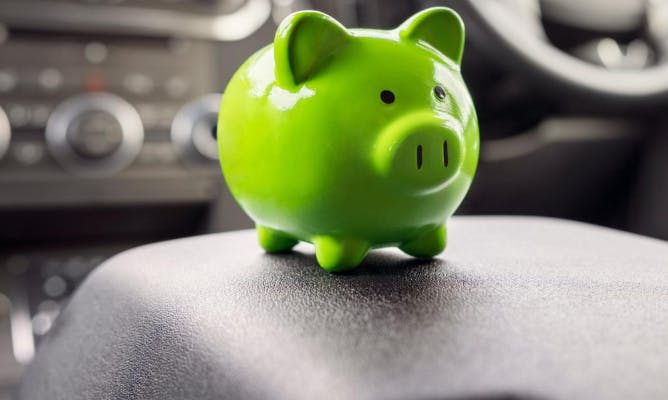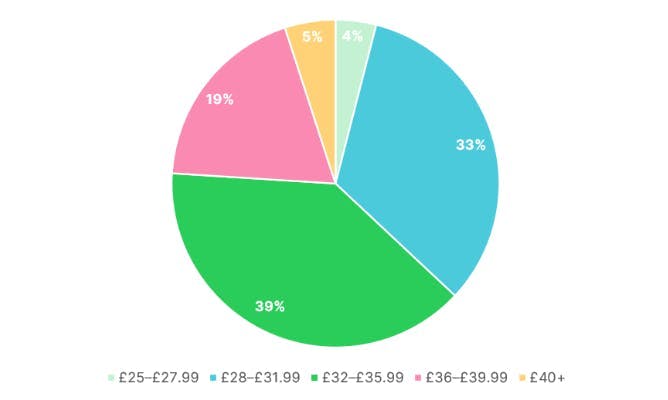
There's no doubt that learning to drive is one of the most important life skills you'll ever gain. It's also true that the process of getting your licence comes with costs. However, while theory and practical test prices are the same across the country, driving lesson rates can vary wildly. We've surveyed hundreds of driving instructors across Great Britain to find out how much driving lessons cost, and how your area compares to others. Let's take a look at driving lesson prices in your area!
Average cost of driving lessons in 2022/23
Before we dive into the ways in which driving lesson rates differ, it's good to establish what instructors charge on average. Information on this can often be somewhat patchy with most sources estimating an average cost between £30 and £40, which is why we surveyed over 3,000 ADIs in 100 regions across Great Britain to create a clearer picture of what learners can really expect to pay.
We found that the average driving lesson rate amongst the instructors we spoke to was £33.39. There was plenty of variation, though, with some ADIs charging as little as £26 per hour or as much as £50.
We've compiled the average cost of driving lessons into the tastiest form of chart (pie) right here:

And here are some of our key findings:
It turns out that the estimate of £30–£40 per hour isn't too bad. In fact, 90% of instructors have rates that fall into this bracket. However, we can drill down further.
The most common rate for an hour's driving lesson is £35, with around 10% of instructors charging this exact price. This is reflected in our chart above, which shows that 39% of instructors have rates between £32 and £35.99.
Very few instructors went below the £28 mark, with just 4% of instructors falling into that price bracket. On the pricier end of the scale, 5% of instructors charged £40 or more, with just over 1% of instructors charging £45 or more.
Driving lesson costs by area
If you're familiar with any of the statistics surrounding learning to drive, you'll be aware that regional variation is very common. As it so happens, this pattern holds true when it comes to the cost of driving lessons.
So, how does the picture look where you live? Of the counties, most fall somewhere close to the national average. 16 counties have average driving lesson rates within £1 of that £35 national average.
Surrey and Somerset are the counties with the most ‘average’ rates, just 8p off the nationwide average.
West Midlands had the cheapest average rates, at £26, followed by Inverclyde and West Yorkshire. Meanwhile, East Lothian's average rate of £47 were the most expensive in the nation, followed closely by Argyll & Bute, East Renfrewshire and Edinburgh. It's clear to see that learner's north of the border can expect to pay a little more to get behind the wheel — particularly those in more rural areas.
London's learners, meanwhile, may have better news than they expected. That's because driving lesson rates in the capital have dropped below the national average. With an average of £31, the difference isn't too great, but every penny counts!
Why do driving lesson rates vary?

We now know the what and the where of driving lesson rate variation — but we haven't yet addressed the why. The first is quite simple: instructors can charge what they like. As a result, natural fluctuations easily come into the market. This is particularly likely in areas with few instructors, where little competition means prices may remain higher.
Additionally, in areas where prices are already high, there's little incentive to undercut the market by too much. A related issue is the rural-urban divide. In sparsely populated parts of the country, there's likely to be little competition, and students may only have one or two options to turn to for driving lessons. Urban areas, meanwhile, are likely to have more ADIs. We examined this for our article on which parts of the country have the most instructors. There, we found that the areas with the most instructors in both numerical and density terms were urban areas.
This stat also works in reverse. If you're an instructor covering a predominantly rural area, you'll have to cover more ground to get as many pupils. This means driving further, which in turn pushes up your fuel costs — something which needs to be offset by higher driving lesson rates.
A city-dwelling instructor, however, may be able to find all the pupils they need in a few square miles. Pupils can then benefit from greater choice and lower rates.
As a final point, manual and automatic learners can expect to pay different driving lesson rates. Manual lessons are, it seems, far more common. In fact, of the ADIs we asked, around nine times more teach in manual than automatic cars. Given their rarity, then, it's not surprising to see that automatic lessons are dearer. We found the most expensive automatic lesson was a hefty £50 per hour, compared to a maximum of £45.05 for manual lessons.
How can I get more for my money?
Aside from upping sticks for the big city, there are still plenty of ways you can make learning to drive more cost-effective. Here are our top tips.
① Go manual
Automatic cars are gaining in popularity here in the UK—but they remain a more expensive option than manual cars. Their higher purchase prices, fuel usage and maintenance costs means automatic instructors can expect higher overheads. Learning in an auto can, therefore, be pretty pricey. Getting behind the wheel of a manual is often a cheaper choice here.
As an added benefit, you'll be able to drive either a manual or an automatic after passing — while those with an automatic licence can't change transmission later on.
② Shop around
Instructors in the very same area may offer driving lesson rates that differ by more than £10 an hour. Given that a typical learner needs around 47 hours of practice to become ready for their driving test, this can result in savings of hundreds of pounds if you choose right!
③ Choose courses not lessons
Traditional lessons typically involve driving for only around one hour per week. As you can imagine, this means lots of time spent retreading the same ground—and the pace of learning can be slow. An intensive course, meanwhile, concentrates your learning into a shorter period of time. This means you can focus on learning new skills and constantly refreshing your knowledge.
A PassMeFast course offers drivers the chance to speed up their learning and design a course that suits them. With both intensive and semi-intensive courses available, you can gain the experience you need to become test-ready in weeks, not months — even on a busy schedule.
What's more, the price you pay for a PassMeFast course covers everything you need to becomea fully-qualified driving in one handy price. And you can spread the cost into monthly instalments with one of our finance plans!
We'll schedule your fast-track practical test to take place at the end of your course hours. This means no waiting around and no need for further refresher lessons: once you're ready to take the test, you'll be straight in there.
You can also try our course recommender, which reveals your ideal course using just a few simple questions!
Subscribe for driving advice, offers & more
We'd love to let you know about our courses, news and offers via email. You may unsubscribe at any time.
Star Genie Limited trading as PassMeFast. Company number 10093359
Copyright © 2024 owned by Star Genie Limited
PassMeFast, Blue Tower, MediaCityUK, Salford, M50 2ST

